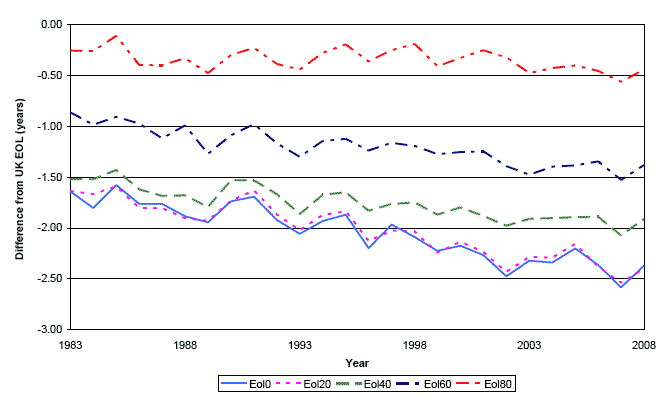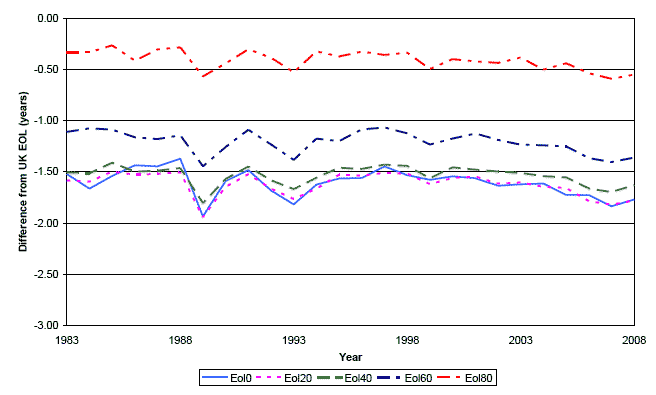
The mortality rates for the first year of the projection, mid-2008 to mid-2009, are based on the best estimates that could be made in the autumn of 2009 of the numbers of deaths at each age in 2008-09.
Assumed improvements in mortality rates after 2008-09 are based on trends in mortality rates before 2008. Improvements in mortality rates by age and gender in the base year of the projection are estimated from the trends in years from 1961 to 2007. It is assumed that annual rates of mortality improvement will converge to a common rate of 1.0 per cent per year at 2033 for most ages, and continue to improve at that constant rate thereafter. However, it is assumed that those born in the years 1923 to 1940 (cohorts which have consistently experienced relatively high rates of mortality improvement over the last 25 years) will continue to experience higher rates of mortality improvement until they die, with assumed rates of improvement in and after 2033 rising from 1.0 per cent a year for those born before 1923 to a peak of 2.5 per cent a year for those born in 1931 and then declining back to 1.0 per cent a year for those born in 1941 or later.
A comparison of period expectations of life (Eols) for Scotland with the UK as a whole (Figure B1) suggests there has been a gradual widening in the difference in expectations of life for males under the age of 80, since the early 1980s. There have also been increases in divergence for females at the younger age groups over the last four of five years (Figure B2).
Figure B1 Period expectations of life (Eol) for Scotland less respective expectation of life for UK – for males at birth and ages 20, 40, 60 and 80

Figure B2 Period expectations of life (Eol) for Scotland less respective expectation of life for UK – for females at birth and ages 20, 40, 60 and 80

Given this finding, further analysis indicated that lower rates of improvement should be adopted in Scotland for males aged 31 to 56 and 67 to 90 and for females aged 32 to 38 and 65 to 90, than for the UK as a whole.
The impact of these new assumptions can be summarised using the period expectation of life at birth, based on the mortality rates for the given year. This life expectancy is assumed to rise from 74.8 years in 2007 to 80.7 years in 2033 for men, and from 79.8 years in 2007 to 85.3 years in 2033 for women. Compared to the assumptions used in the 2006-based projections for Scotland, these lead to very small increases in the expectations of life at birth for men of around 0.1 years in 2033, and for women of 0.2 years.